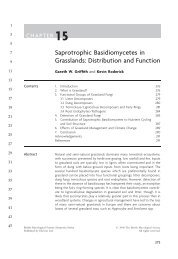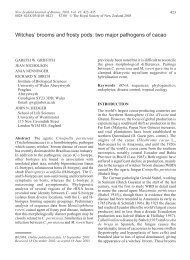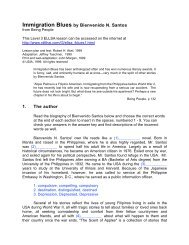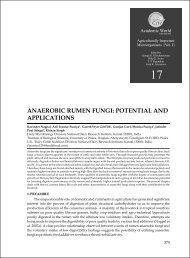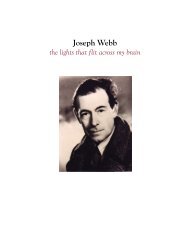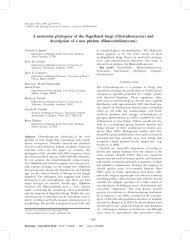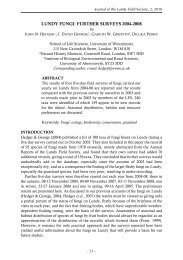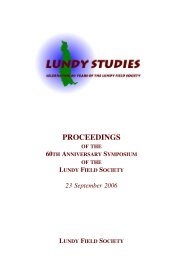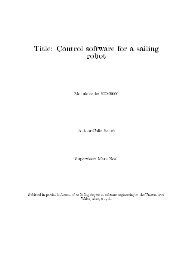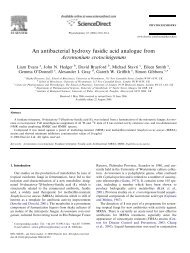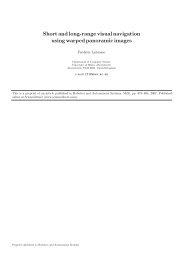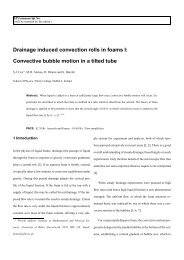Download the pdf - Users Site
Download the pdf - Users Site
Download the pdf - Users Site
Create successful ePaper yourself
Turn your PDF publications into a flip-book with our unique Google optimized e-Paper software.
However, during our search for U. violacea along <strong>the</strong> shale cliffs below and<br />
above <strong>the</strong> Beach Road in April 2005 we did find a number of o<strong>the</strong>r interesting<br />
pathogens on <strong>the</strong> cliff plants. On <strong>the</strong> lower cliff, in <strong>the</strong> splash zone, leaves of scurvy<br />
grass (Cochlearea officinalis) were heavily incrusted with white spores of downy<br />
mildew, Albugo candida. Higher up, records included dark patches on leaves of<br />
foxglove, (Digitalis purpurea), caused by Ascochyta molleriana, and yellow patches<br />
on leaves of cuckoo pint (Arum maculatum) caused by Ramularia ari, both very<br />
common fungi on <strong>the</strong>se hosts on Lundy. Of particular interest were pathogens on<br />
plants considered by Hubbard (1997) to be Lundy rarities: <strong>the</strong> Phomopsis state of<br />
Diapor<strong>the</strong> arctii was found bleaching patches on leaves of <strong>the</strong> locally abundant<br />
balm-leaved figwort (Scrophularia scorodonia), but <strong>the</strong> most exciting find was a<br />
species of Mycosphaerella, causing brown lesions (Plate 15) on leaves of <strong>the</strong> Lundy<br />
cabbage, Coincya wrightii. It is as yet undetermined, but is possibly M. brassicola,<br />
or an undescribed, host-specific species, and <strong>the</strong>refore a Lundy endemic. More<br />
material needs to be examined before this question can be answered.<br />
The Plateau<br />
On <strong>the</strong> Plateau, <strong>the</strong> very extensive areas of grassland, and heath, maintained by <strong>the</strong><br />
intensive grazing and exposure on Lundy, represent a very important habitat for fungi,<br />
indeed one which is of significant conservation interest for <strong>the</strong> whole of <strong>the</strong> U.K.<br />
Following Hubbard (1997) we have distinguished four main types of fungal<br />
habitat on <strong>the</strong> plateau: 1) short-cropped turf, comprising most of Middle Park, much<br />
of Ackland’s Moor, <strong>the</strong> Airfield, <strong>the</strong> South West Field and Castle Hill; 2) taller and<br />
matted grassland, with Molinia and bracken, especially <strong>the</strong> area between Quarter<br />
Wall and Halfway Wall, with a subset of much wetter areas with Sphagnum,<br />
Molinia and Juncus around Pondsbury, in <strong>the</strong> Punchbowl Valley and in <strong>the</strong> shallow<br />
valley running down <strong>the</strong> east side of <strong>the</strong> island beside Quarter Wall to <strong>the</strong> Quarries;<br />
3) <strong>the</strong> walled off areas of improved grassland around <strong>the</strong> farm; 4) <strong>the</strong> Calluna vulgarisdominated<br />
areas north of Threequarter Wall. Of <strong>the</strong>se habitats, <strong>the</strong> enclosed fields<br />
around <strong>the</strong> farm are most species-poor in both plants and fungi. In contrast, <strong>the</strong> most<br />
species-rich areas for macrofungi are <strong>the</strong> short-cropped turf, followed by <strong>the</strong> taller<br />
grassland and <strong>the</strong> Calluna. Mostof<strong>the</strong>fungirecordedaredecomposers,growingon<br />
plant litter or herbivore dung, but we did find one woodland mycorrhizal species, <strong>the</strong><br />
‘cob web agaric’ Cortinarius anomalus,associatedwith<strong>the</strong>clumpsofwillowandgorse<br />
by <strong>the</strong> Threequarter Wall gate on <strong>the</strong> east side of <strong>the</strong> island.<br />
1. Short Turf Grassland<br />
The decomposer macrofungi of <strong>the</strong> short cropped grassland are <strong>the</strong> most obvious to<br />
<strong>the</strong> visitor to <strong>the</strong> island in autumn, especially since <strong>the</strong>y are abundant in <strong>the</strong> area<br />
around Lundy Old Light. However <strong>the</strong> nearby Airfield is ano<strong>the</strong>r ‘hotspot’, as is <strong>the</strong><br />
west side of Middle Park. They include large agarics such as <strong>the</strong> ‘parasol mushroom’,<br />
Macrolepiota procera, <strong>the</strong> ‘field mushroom’, Agaricus campestris, <strong>the</strong> ‘horse<br />
mushroom’, Agaricus arvensis and <strong>the</strong> purple coloured ‘wood blewitt’, Lepista nuda.<br />
In <strong>the</strong> short turf it is easy to see that many of <strong>the</strong>se decomposer fungi grow through<br />
- 152 -



